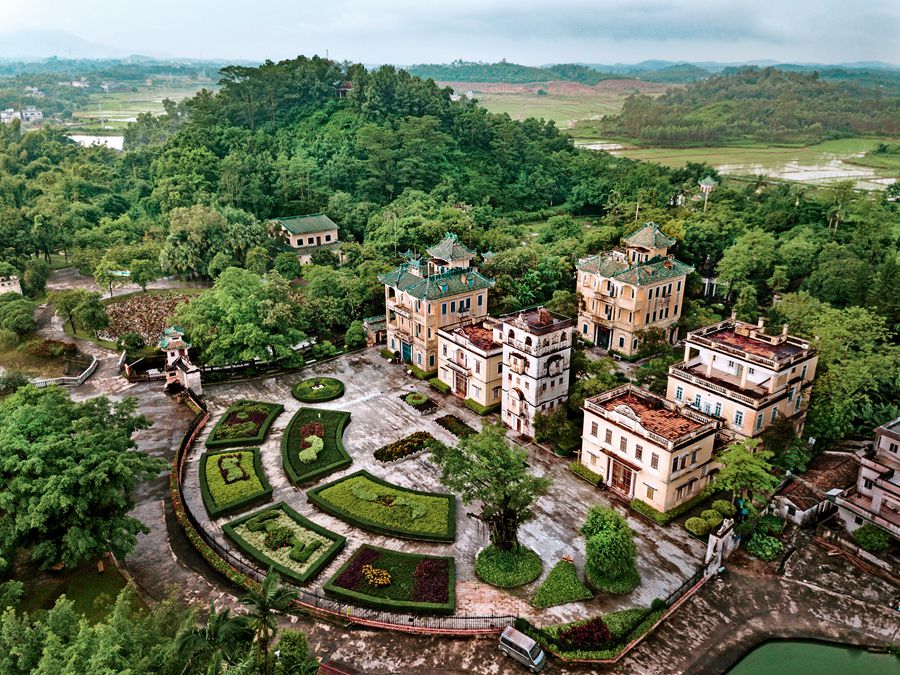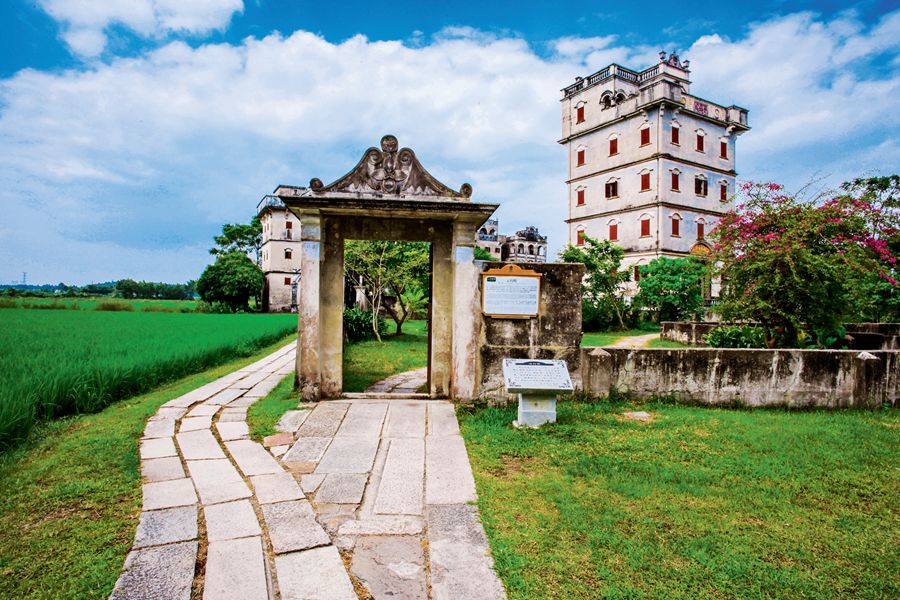DIAOLOU is a fortified residential dwelling. It functions both as a house and a fortress. The city of Kaiping in Guangdong Pro-vince is dotted with all kinds of magnificent Diaolous. As they display a mixture of Chinese and Western architectural styles, they have therefore become a special kind of architecture in rural China.

A bird’s-eye view of a group of magnificent Diaolous in south China’s Kaiping.
The rise of the Diaolou is closely linked with specific social conditions. In the late Ming Dynasty (1368-1644), as a result of rampant bandits in Kai-ping, much social unrest ensued. Besides, frequent typhoons and heavy rainfall led to frequent flooding. To fight against these calamities, the locals began to build lofty Diaolous. In the late Qing Dynasty (1644-1911), those who had migrated overseas to earn a living came back with much wealth, which attracted the attention of local bandits. In order to stay safe, they chose to build fortified Diaolous as homes. Later, during the Republic of China (1912-1949), the number of Diaolous in Kaiping expanded to as many as 3,000. Today, there are 1,800 left.
The Diaolou’s walls stand high and solid, with narrow windows. It gave the dwellers a commanding position from inside when there were invaders outside. Besides this, there are embrasures on the walls of each Diaolou, allowing retaliation from a safe, guarded position.
In terms of function, the Kaiping Diaolou can be classified into three kinds: watch towers, communal towers, and residential towers.

The Diaolou is a witness to Kai-ping’s political, economic, and cultural development.
There are two kinds of watch towers. The ones built outside the village are called light towers, which were jointly built by several neighboring villages in response to local bandit activities and equipped with lights, guns, and other needed equipment.
The other kind of watch tower was usually built at the entrance of a village where men stood on guard in turn. They also set up surveillance day and night to protect villagers.
Besides watch towers, there are communal towers, which were built by several families or the whole village and used as temporary shelter.
Residential towers were a relatively new type built by individual rich families and used as fortified residences. In the early years of the Republic of China period, wealthy local families were particular about the living environment of the Diaolou. They wanted it to be not only defensive but also functional in daily life, as a result of which kitchens, bathrooms, and studies were added.
Residential towers were mostly funded by the owners solely. They stand tall and spacious, have different shapes, and are equipped with exquisite decorations, a reflection of the owner’s tastes. These specialties make this kind of tower the most artistic kind of all Diaolous.

A Diaolou with a yard stands out in the countryside of Kaiping.
The tall Diaolou and low village houses form a skyline full of variety. Besides, with the continuous integration of Western architectural styles, the aesthetic taste of Kaiping residents has also changed accordingly, and the overall shape of the Diaolou has gradually changed from simple to complicated, resulting in a unique hybrid fusion of Chinese and Western styles.
This style is best embodied in the components of the upper part of the building. At the request of the owners of the building, craftsmen brought together the architectural elements of colonnades, arches, vaults, arcades, and elements of castles in ancient Greek, Roman, and Islamic styles, allowing the towers to retain their native characteristics while displaying different foreign styles and radiating a unique artistic charm.
Intricately detailed decorations are also something valued on those building elements. Ash carving is normally used. This craft uses a mortar made from shells as the main material, and looks uniquely impressive, which now has become an intangible cultural heritage of China. The motifs of the minute adornments include auspicious Chinese words and animal patterns, and also Western flowers, plants, and geometrical patterns.
In the center of a Diaolou, there always hangs a horizontally inscribed plaque with the name of the Diaolou on it. The name often contains good wishes of the owner. Above the plaque is a common architectural component in Western architecture, pediment, which reflects the owner’s embrace of Western aesthetics and open-mindedness.
The Diaolou, with its strong classical European style, is quite a treat for the eyes in the countryside of Kaiping. It was the different living spaces and aesthetics of overseas Chinese that enabled the harmonious integration of Western architectural styles, thus creating the various shapes of Kaiping Diaolou. These Diaolous bear witness to the political, economic, and cultural development of Kaiping, a living museum of modern architecture and a unique art gallery.
GUO ZHIDONG is a researcher of traditional culture at the No.93 Courtyard Museum.


